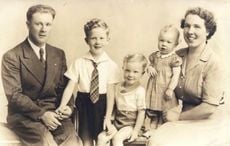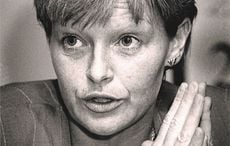| Billy the Kid |
For celebrated writer Pete Hamill, you have to include a photo of Billy the Kid, “an Irish American from the Five Points who took Horace Greeley's advice and went west.”
For New York Times columnist Dan Barry, you must include movie posters from the many 1930s films which focused on Irish American life, such as Angles with Dirty Faces, The Roaring Twenties and The Fighting 69th.
And to novelist Peter Quinn, an ironworker’s gloves and Eugene O’Neill’s desk are too important to ignore.
Two weeks ago I wrote a column noting that there is worldwide interest these days in trying to tell the story of a culture through a handful of physical objects.
From Ireland to the U.K. to America, books have been written, museum exhibits established and debates held over how certain objects can define a culture.
So I asked the question -- what objects define Irish America? Boy, did I get a lot of answers.
Aside from Billy the Kid, Hamill, whose parents came from Belfast, suggested copies of sheet music written for the Irish in America, highlighting tunes such as "I'll Take You Home Again, Kathleen."
Hamill also suggested Jimmy Cagney movie posters, tickets stubs from a John McCormack concert, Thomas Nast’s infamous anti-Irish cartoons and Mike Quill’s Transit Workers Union I.D. card.
Campaign buttons from Al Smith and JFK, the covers of James T. Farrell’s Studs Lonigan books, a Pogo comic strip by Walt Kelly, a photo of gangster Owney Madden and (of course) press credentials from great Irish American journalists were other items Hamill (quite a journalist himself) suggested.
| Gene Kelly |
Quinn, author of Banished Children of Eve and Looking for Jimmy, suggested the following -- a grand marshal's sash from the Fifth Avenue St. Patrick's Day Parade, "Wild Bill" Donovan's Congressional Medal of Honor (housed in the 69th Regiment Armory on Lexington Avenue), the banner of the Irish Brigade, a bucket and scrub brush, O'Neill's desk, a nun's habit, sheet music from Harrigan and Hart, ironworker's gloves, a union pin (“or the sash my grandfather wore to lead the 1904 New York City Labor Day parade”), Gene Kelly's dancing shoes, the cap James Cagney wore in Yankee Doodle Dandy, a First Communion boy's arm band/girl's dress, a shovel or spade, Grace Kelly's riding outfit from Philadelphia Story, a fireman's helmet, Bing Crosby's bow tie, a bottle shard from the Five Points, a cop's billy club and (finally) Legs Diamond's pistol.
It wasn’t just ink-stained wretches like Hamill and Quinn who responded. Reader Damian McShane of the Bronx, responding through Facebook, suggested a fight poster of famous boxer John L. Sullivan as well as Congressman Tip O’Neill's gavel.
Maureen Duffy, of Salt Lake City, added, “You would of course need to find one of the signs that my great-grandfather and great-uncles saw again and again when looking for work in New York and Connecticut in the 1860's -- the signs that said Help Wanted: No Irish Need Apply.
“And then, of course, there's the police van which became termed (and still is) the ‘Paddywagon’ from its use in, supposedly, picking up drunk and fighting Irishmen from the streets of New York and depositing them in the ‘clink’ or ‘pokey’ (which are both slang phrases used by the Irish designating gaol).”
New York Times columnist Barry also wanted Irish American pop culture represented.
“I would suggest something from George M. Cohan -- some sheet music, perhaps. I know there's a statue of Cohan in the Fox Point section of Providence, at the top of Wickenden Street.
| 'Yankee Doodle Dandy' ad which starred James Cagney |
“You might also consider a Warner Brothers movie from the 1930s, one that captures that New York Irish sensibility. There are plenty, whether gangster or military, starring Jimmy Cagney, Pat O'Brien, and Frank McHugh. The Fighting 69th, Angels With Dirty Faces, The Roaring Twenties.”
Tom Murphy, who heads up the retirees chapter of the United Federation of Teachers (and also happens to be my cousin), suggested a host of more domestic items, such as front door holy water fonts, lace curtains, St. Patrick’s Day cards, women's tam-o-shanters and scarves, rosary beads/scapulars/crucifix, a racing form or OTB ticket or the Irish Sweepstake receipt and prayer cards from wakes.
Murphy also suggested a voting booth, a photo of JFK, a Cead Mile Failte plaque and (finally) last year’s palms, to be burned to ashes.
Historian and author Thomas Fleming appreciated a suggestion I made two weeks ago -- a copy of a famous book by Cotton Mather, which mentions the execution of Irish Catholic immigrant and accused witch Goody Glover, whose religion and ethnicity made her a target.
“In the tradition of Goody Glover,” Fleming wrote, “I'd suggest a picture of Lyman Beecher, father of Harriet B. Stowe and Henry Ward Beecher. He crusaded for decades against the Catholic (mostly Irish) menace.
“He's got a face that emanates prejudice, a sort of permanent scowl.”
Former Irish Voice reporter Georgina Brennan, replying from Ireland, wanted to highlight Irish music.
"A copy of McNally's Row of Flats by Mick Maloney, which contains some of the best Irish children’s songs long, long ago forgotten." Readers Dick and Kit Wheatley also had music on their minds, reserving a special place for the pipes played at funerals and any songs which long for “home.”
Author and historian Kevin Baker went back to the 19th century, saying any story of the Irish in the U.S. could not be told without a Union army field cap from the Civil War or a banner representing the San Patricios, who fought on the side of Mexico in the Mexican-American war.
Baker also suggested, “A growler, with which to talk about the constant, disastrous attempts by the codfish aristocracy to ‘tame’ the Irish through temperance. A pair of tap shoes, Dagger John Hughes’ clerical robes, the rusty-colored old priest’s frock Francis Cardinal Spellman liked to wear when he was pretending to be a simple country prelate around The Powerhouse and, finally, the spikes of Mike “King” Kelly, the first real Irish, team-sport superstar.”
Matt Patterson, a dentist working on the Duffy’s Cut archaeological project in Pennsylvania, said we should “include a piece of railroad track and an item from a canal boat or mule harness that pulled canal boats.
“The Irish built the Eastern railroads and canals, and the Duffy’s Cut Project historians say that for every mile of railroad and canal in this country, there's a dead Irishman.”
Reader Michael Brennan also had Pennsylvania on his mind. He suggested “company ‘money’ paid to the Irish in the Pennsylvania coal fields, good at the company store or bar but not the train station.”
Irish Brigade Civil War banners (from the North and South), a nun with a ruler in her hand and a film clip showing George M. Cohan, played by Cagney, in Yankee Doodle Dandy were also important to Brennan.
What’s clear from all of this is that the story of the Irish in America is a rich and diverse one.
Gathering all of these artifacts would be quite a task. Then again, compared to surviving in the U.S., it doesn’t seem so daunting.
(Contact “Sidewalks” at [email protected] or facebook.com/tomdeignan)




Comments